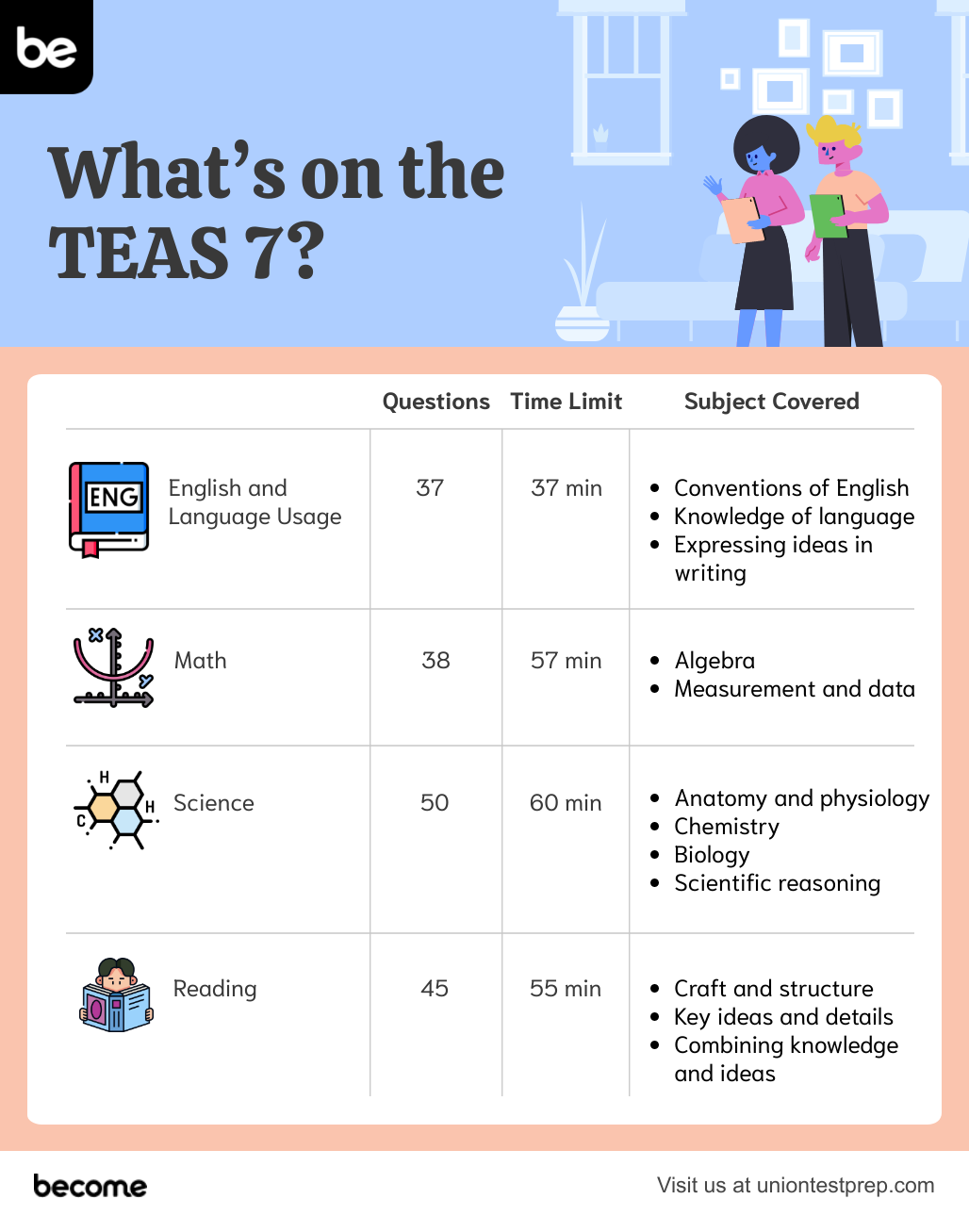
What Is on the New TEAS 7?
As of June 3, 2022, only the newest version of the TEAS will be available—the TEAS 7. This test has been changed to better align the results with competencies needed in nursing and allied health fields and to better fit with the Common Core State Standards. You may wonder what these changes are and how they will affect your test-taking experience. Please read on!
If you are preparing for the TEAS 7, it may not seem important to know how the test has changed, but being aware of the changes may give you some idea of where thoughts are headed in terms of what is important for pre-healthcare workers to know.
In What Ways Has the TEAS Changed?
The most significant areas in which the TEAS 7 is different from the TEAS 6 concern the question types in the online version of the test and some of the specific skills assessed in each of the four sections. The entire test has not undergone a major revision, but there are some important differences.
Additional Question Types in the Online Test
If you take the paper and pencil version of the TEAS 7, the question type will be the same: typical multiple-choice questions with four answer choices. However, in the online version of the TEAS 7, you will see a few different question presentations that will require you to answer in various new ways. Here are the new question types you will see:
Multiple-Select Questions
These questions differ from the usual multiple-choice questions in two ways. First, there may be more than four answer choices, and, secondly, you will need to choose more than one answer. For example, the question may say, “Which two of the following…?” or it may not give a number of responses to choose and you’ll need to pick only those that are correct. To receive credit for a correct answer to these questions, you must select all of the correct answers and only the correct ones. There is no credit given for being “partially” correct.
Supply Answer Questions
Basically, you’ll need to come up with the correct answer to these questions on your own. There will be no answers to choose from. So, it will be similar to filling in a blank on a written test. You’ll have to type your answer in a space.
Ordering Questions
This question type requires you to arrange things in the correct sequence. The items may be steps in a process that need to be done in a certain order. Alternatively, things may need to be arranged from smallest to largest, for example. To accomplish the arrangement, it will be necessary to either “drag and drop” the items into place or place numbers beside the items to show their order. Again, there is no credit given for parts of the response that are in the correct order. You must have all of them in the right order for your answer to be considered correct.
Hot Spot Questions
To answer this type of question, you will need to refer to an image that contains two to five spots that are clickable with your mouse and cursor. The question will ask you to choose a certain area of the image and you should stop on the spot that answers the question and click it to select an answer. For example, you may be asked to find a certain part of anatomy or a certain type of word in a sentence.
Slight Differences in the Content Assessed
The TEAS 7 contains the same four major content areas, but some of the concepts assessed and the topic emphases have changed a bit. In other words, the section names have not changed, but some of the content has. Here are the important changes to know about.
The Reading Section
There are now fewer questions in the Reading section, down from 53 to 45, but the time limit is reduced also. You’ll be given 55 minutes to complete the questions instead of the previous 64 minutes.
The emphasis on your ability to think about knowledge and ideas and integrate them is greater on the TEAS 7, while there are fewer questions about craft, structure, key ideas, and details. So, the questions have moved toward asking you to really think about things instead of just finding evidence in a passage to answer questions.
The Mathematics Section
The Mathematics section of the TEAS 7 is not that different in terms of the number of questions or time limit. You’ll now have 57 minutes to answer 38 questions, instead of 54 minutes to answer 36 questions.
On the other hand, skill emphasis has shifted a bit. There will now be approximately an equal number of questions related to algebra and numbers as there are about measurement and data. The previous edition of the test placed more emphasis on algebraic concepts.
The Science Section
As in the Reading section, both the number of questions and the time allowed have been reduced in the Science section of the TEAS 7. Before, 63 minutes were allotted to answer 53 questions. Now, there will be only 50 questions to answer in 60 minutes. So, nearly the same time is allotted per question.
The content areas tested in the Science section show the biggest changes in the TEAS 7. Here’s what’s the same and what’s different:
Similarities
There are still a number of questions on human anatomy and physiology, but these questions make up a smaller percentage of the total science questions: from 68% on the previous test to just 40% on the new TEAS 7.
Scientific reasoning questions are still a part of this test, to a slightly greater degree. They now make up about 20% of the TEAS 7, while only 15% of the previous Science section was allotted to them.
Differences
The life and physical sciences category of questions is no longer a part of the TEAS 7 Science section.
Instead, there are two new areas of study tested: biology and chemistry. Approximately 20% of the TEAS 7 Science section questions are devoted to each of these topics.
The English Language and Usage Section
The TEAS 7 English section contains more questions and a longer time in which to answer them. You’ll now have 37 minutes to answer 37 questions, as opposed to the previous presentation of 28 questions with a 28-minute time limit.
The most important thing to know about the new English section is that there is an increased emphasis on being able to apply your English skills in writing. In other words, not only will you need to know vocabulary words, but you’ll also need to be able to tell how to use them when writing.

No, just knowing all this will not get you a super score on the TEAS 7, but being aware of the current concept emphasis may help you know where to direct your study and preparation. So, take this knowledge and apply it to some serious prep for your test!”
Keep Reading

Test of Essential Academic Skills Blog
How to Pass the TEAS Science Section
As a pivotal component of the Test of Essential Academic Skills (TEAS),…

Test of Essential Academic Skills Blog
How Long Should I Study for the TEAS Test?
According to the Bureau of Labor, there are over 3 million registered n…

Test of Essential Academic Skills Blog
Making a Studying Plan for the TEAS Exam
Are you preparing to take the ATI TEAS exam? This important test can be…